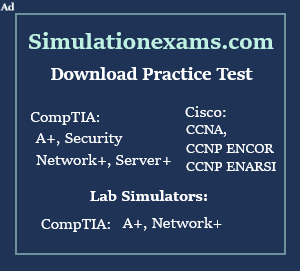2) Privilege Exec---provides a high-level management
access to the IOS,User EXEC mode command can also be used
at this mode
3) Configuration-----provides commands for configuring
device
1.a User EXEC Mode
The initial access to the CLI is done through this mode.
Depending upon the configuration of the router user may be prompted
for password. This mode is typically used for monitoring and
troubleshooting the device, it has a very limited set of commands.
This mode is identified by the prompt as ">".
R1>
Here left to the prompt is the device name.
1.b Privilege EXEC Mode:
Giving "enable" command at the above mode lets you enter
to this mode. If the privilege EXEC password has been set, then
you will be prompted for the password.
This mode is identified be the prompt as "#".
R1#
In this mode, we can also use the User EXEC mode commands,
this mode has more advanced management and troubleshooting commands.
We cannot use the commands that modify the device configuration.
1.c Configuration Mode:
Use the "configure terminal" command at Privilege EXEC Mode
to enter to this mode, as shown in the below example.
R1#configure terminal
R1(config)#
Prompt at this mode is "(config)#".
Use the command in this mode to change the configuration
of the device.
We cannot view the configuration changes at this mode for
this we have to go back to Privilege EXEC Mode by either typing
"end" or pressing the control sequence CTRL-Z,
1.d Sub-configuration mode:
Configuration mode has two different levels:
- Global Configuration mode and
- Sub-configuration. mode
At the Sub-configuration mode, the commands that are entered
affect only specific component of the device.
The following are the different sub-configuration modes and
their corresponding prompts
| Mode |
prompt |
| Interface Subconfiguration mode |
(config-if)# |
| Subinterface Subconfiguration mode |
(config-subif)# |
| Line Subconfiguration mode |
(config-line)# |
| Controller Subconfiguration mode |
(config-controller)# |
| IP Routing Protocol Subconfiguration mode |
(config-router)# |
To leave a Sub-configuration mode and return to Global Configuration
mode, use the exit command
2. Router Interface Configuration:
Interface Naming
Depending on the device interfaces can be either fixed, modular
or both.
For Routers that have only fixed interfaces, the interface
nomenclature is
type port_#.
If the router as two fixed serial interfaces they are name
as serial 0 and serial 1
If the router has modular slots, the interface nomenclature
is like type slot_#/port_#.
Each slot begins with 0 and has a unique slot number.within
each slot port numbers begin at 0 and move their way up.
For example a modular router with two slots has slot 0 as
first slot and slot 1 as second slot.if the first slot has 4
serial interfaces they are numbered from 0 to 3 and the if the
second slot has 2 serial interfaces they are numbered as 0 and
1 as shwn in the below representation.
First slot - serial 0/0, Serial 0/1, Serial 0/2, Serial 0/3
Second slot - serial 1/0,serial 1/1
Sub-interfaces
Router's physical interface can be broken down into multiple
logical interfaces called sub-interfaces. Once the sub-interface
is created router will treat this logical interface just like
a physical interface. Below is the sub-interface nomenclature
type port_#.subinterface_#
Example
Sub-interface number 0 on a physical interface "serial
0" is represented as
serial 0.0
Example 1: Here we configure the hostname on a router.
R1>enable
R1#configure terminal
R1(config)#hostname bangalore
bangalore(config)#
bangalore(config)#exit
bangalore#
Example 2: Here we configure the IP address on an interface
of a router.
R1>enable
R1#configure terminal
R1(config)#interface serial 0
R1(config-if)#ip address 192.168.1.1 255.255.255.0
R1(config-if)#exit
R1(config)#exit
R1#
3. RIP Configuration Using Cisco® IOS
RIP is a dynamic routing protocol. Configuring RIP on a Cisco
router is given below. The network 192.168.1.0 is enabled for
RIP.
R1>enable
R1#configure terminal
R1(config)#router rip
R1(config-router)#network 192.168.1.0
R1(config-router)#exit
R1(config)#exit
R1#




